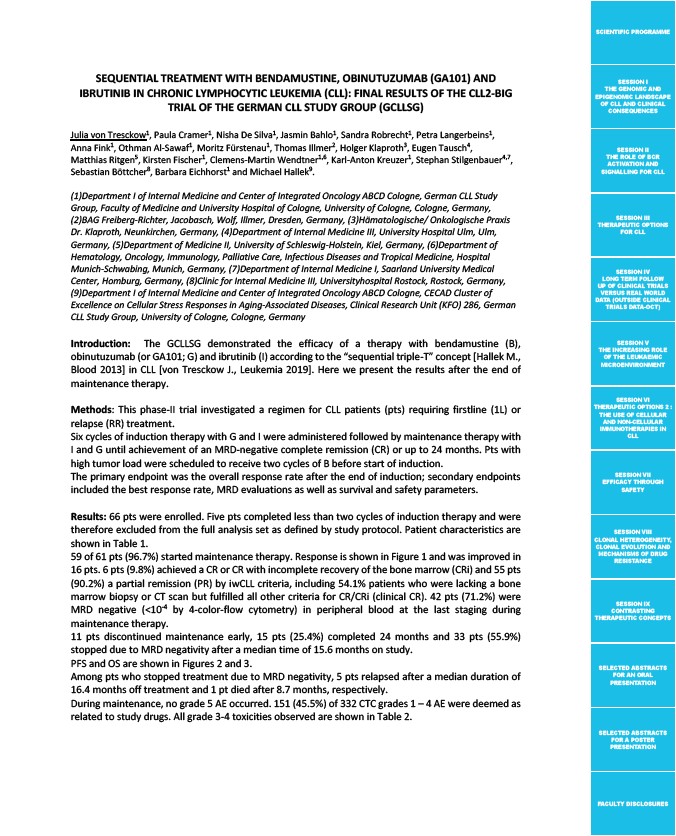
SCIENTIFIC PROGRAMME
SESSION I
THE GENOMIC AND
EPIGENOMIC LANDSCAPE
OF CLL AND CLINICAL
CONSEQUENCES
SESSION II
THE ROLE OF BCR
ACTIVATION AND
SIGNALLING FOR CLL
SESSION III
THERAPEUTIC OPTIONS
FOR CLL
SESSION IV
LONG TERM FOLLOW
UP OF CLINICAL TRIALS
VERSUS REAL WORLD
DATA (OUTSIDE CLINICAL
TRIALS DATA-OCT)
SESSION V
THE INCREASING ROLE
OF THE LEUKAEMIC
MICROENVIRONMENT
SESSION VI
THERAPEUTIC OPTIONS 2 :
THE USE OF CELLULAR
AND NON-CELLULAR
IMMUNOTHERAPIES IN
CLL
SESSION VII
EFFICACY THROUGH
SAFETY
SESSION VIII
CLONAL HETEROGENEITY,
CLONAL EVOLUTION AND
MECHANISMS OF DRUG
RESISTANCE
SESSION IX
CONTRASTING
THERAPEUTIC CONCEPTS
SELECTED ABSTRACTS
FOR AN ORAL
PRESENTATION
SELECTED ABSTRACTS
FOR A POSTER
PRESENTATION
FACULTY DISCLOSURES
SEQUENTIAL TREATMENT WITH BENDAMUSTINE, OBINUTUZUMAB (GA101) AND
IBRUTINIB IN CHRONIC LYMPHOCYTIC LEUKEMIA (CLL): FINAL RESULTS OF THE CLL2-BIG
TRIAL OF THE GERMAN CLL STUDY GROUP (GCLLSG)
Julia von Tresckow1, Paula Cramer1, Nisha De Silva1, Jasmin Bahlo1, Sandra Robrecht1, Petra Langerbeins1,
Anna Fink1, Othman Al-Sawaf1, Moritz Fürstenau1, Thomas Illmer2, Holger Klaproth3, Eugen Tausch4,
Matthias Ritgen5, Kirsten Fischer1, Clemens-Martin Wendtner1,6, Karl-Anton Kreuzer1, Stephan Stilgenbauer4,7,
Sebastian Böttcher8, Barbara Eichhorst1 and Michael Hallek9.
(1)Department I of Internal Medicine and Center of Integrated Oncology ABCD Cologne, German CLL Study
Group, Faculty of Medicine and University Hospital of Cologne, University of Cologne, Cologne, Germany,
(2)BAG Freiberg-Richter, Jacobasch, Wolf, Illmer, Dresden, Germany, (3)Hämatologische/ Onkologische Praxis
Dr. Klaproth, Neunkirchen, Germany, (4)Department of Internal Medicine III, University Hospital Ulm, Ulm,
Germany, (5)Department of Medicine II, University of Schleswig-Holstein, Kiel, Germany, (6)Department of
Hematology, Oncology, Immunology, Palliative Care, Infectious Diseases and Tropical Medicine, Hospital
Munich-Schwabing, Munich, Germany, (7)Department of Internal Medicine I, Saarland University Medical
Center, Homburg, Germany, (8)Clinic for Internal Medicine III, Universityhospital Rostock, Rostock, Germany,
(9)Department I of Internal Medicine and Center of Integrated Oncology ABCD Cologne, CECAD Cluster of
Excellence on Cellular Stress Responses in Aging-Associated Diseases, Clinical Research Unit (KFO) 286, German
CLL Study Group, University of Cologne, Cologne, Germany
Introduction: The GCLLSG demonstrated the efficacy of a therapy with bendamustine (B),
obinutuzumab (or GA101; G) and ibrutinib (I) according to the “sequential triple-T” concept Hallek M.,
Blood 2013 in CLL von Tresckow J., Leukemia 2019. Here we present the results after the end of
maintenance therapy.
Methods: This phase-II trial investigated a regimen for CLL patients (pts) requiring firstline (1L) or
relapse (RR) treatment.
Six cycles of induction therapy with G and I were administered followed by maintenance therapy with
I and G until achievement of an MRD-negative complete remission (CR) or up to 24 months. Pts with
high tumor load were scheduled to receive two cycles of B before start of induction.
The primary endpoint was the overall response rate after the end of induction; secondary endpoints
included the best response rate, MRD evaluations as well as survival and safety parameters.
Results: 66 pts were enrolled. Five pts completed less than two cycles of induction therapy and were
therefore excluded from the full analysis set as defined by study protocol. Patient characteristics are
shown in Table 1.
59 of 61 pts (96.7%) started maintenance therapy. Response is shown in Figure 1 and was improved in
16 pts. 6 pts (9.8%) achieved a CR or CR with incomplete recovery of the bone marrow (CRi) and 55 pts
(90.2%) a partial remission (PR) by iwCLL criteria, including 54.1% patients who were lacking a bone
marrow biopsy or CT scan but fulfilled all other criteria for CR/CRi (clinical CR). 42 pts (71.2%) were
MRD negative (<10-4 by 4-color-flow cytometry) in peripheral blood at the last staging during
maintenance therapy.
11 pts discontinued maintenance early, 15 pts (25.4%) completed 24 months and 33 pts (55.9%)
stopped due to MRD negativity after a median time of 15.6 months on study.
PFS and OS are shown in Figures 2 and 3.
Among pts who stopped treatment due to MRD negativity, 5 pts relapsed after a median duration of
16.4 months off treatment and 1 pt died after 8.7 months, respectively.
During maintenance, no grade 5 AE occurred. 151 (45.5%) of 332 CTC grades 1 – 4 AE were deemed as
related to study drugs. All grade 3-4 toxicities observed are shown in Table 2.